There are 16 native species of turtles in South Carolina with 5 sea turtle species that occasionally visit the coast, for a total of 21 turtles in and around the Palmetto State. South Carolina has warm humid summers, moderately mild winters, and plenty of suitable habitats for turtles.
Several species are endangered, threatened, or otherwise in decline, so it’s up to us to help keep them around. If you’re looking for a pet turtle, be sure to look for a licensed, ethical breeder, and don’t take turtles from the wild. Many are legally protected.
Besides being unlawful to take most turtles, it harms them and their environment. Turtles are beneficial and necessary to nature. When they are removed from their natural habitat, they will stress out, some will not eat, and their life is drastically shortened.
You can use this list to help you find a legal, captive bred pet, or simply as a herping guide while exploring the state. Maybe you are simply curious and want to know what turtles live where. Whatever the case, we’re glad you’re here, so let’s get to it.
Here are the native turtles of South Carolina.
Table of Contents
Turtles in South Carolina
1. Bog Turtle
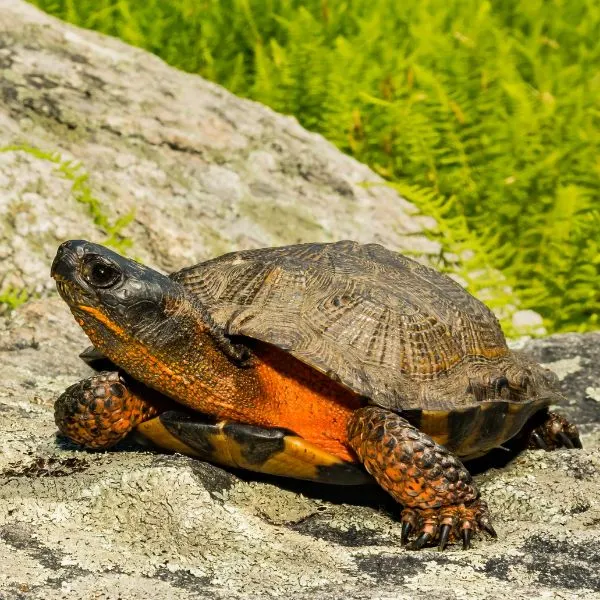
- Experience Level: *Expert
- Family: Emydidae
- Scientific Name: Glyptemys muhlenbergii
- Other Names: Muhlenberg’s turtle
- Adult Size: 3.5 to 4 inches
- Life Span: Up to 60 years in the wild
- Average Price Range: *Illegal to own, Federally protected species
- Conservation Status: Endangered
The smallest species of turtle in North America, Bog turtles are also quite endangered. One good thing is they are a flagstone species. This means that because people want to save this cute, tiny turtle, they will inevitably help to save their habitat.
These little tykes live in wetlands, bogs, marshes, swamps, and other similar areas. So, when efforts turn to save these turtles, the wetlands will be protected as well. This helps save birds, fish, flora, and many other threatened animals that we don’t know that much about.
Bog turtles only grow to about 3 to 4 inches long, they are dark colored, can even be black, and have bright red or orange patches behind their eyes. They are semi aquatic, so they spend time in the water and roam around on land or the thick vegetation.
They will feed on small invertebrates such as worms, leeches, insects, and snails, but they will also eat plants and seed pods.
2. Spotted Turtle

- Experience Level: Intermediate to Expert
- Family: Emydidae
- Scientific Name: Clemmys guttata
- Other Names: Polka-dot turtle, “Spotty”
- Adult Size: 4 to 5 inches
- Life Span: Males up to 65 years; females up to 110 years
- Average Price Range: $200 to $300
- Conservation Status: Endangered
Another small, endangered turtle is the Spotted turtle. These turtles do range into South Carolina but sightings have been incredibly rare. Like the little Bog turtle, “Spottys” live in bogs, and marshes too.
They are similar in size but are black on the shell and skin. As the name suggests, they have bright yellow or whitish spots all along the carapace (the name for the upper shell on turtles) and their head, neck, and limbs.
Spotted turtles are very smart, and have been compared to the intelligence of mice.
Spotted turtles are omnivores that feed on snails, worms, spiders, small crustaceans, insects, and plants.
Box Turtles in South Carolina
3. Eastern Box Turtle

- Experience Level: Beginner
- Family: Emydidae
- Scientific Name: Terrapene carolina carolina
- Other Names: Land Turtle
- Adult Size: 4 to 7 inches
- Life Span: 50 to 100 years
- Average Price Range: $260 – $360
- Conservation Status: Michigan, New Hampshire, Massachusetts, and Connecticut—list the animal as a species of special concern, and Maine lists the turtle as endangered.
Eastern Box turtles are one of the very few species that are terrestrial. They are considered turtles, but they don’t spend much time in water and rarely completely submerge themselves. They are quite content to roam on land their entire lives, though they do stay near a water source.
You’ll find Eastern Box turtles in forests, wetlands, and humid grassland areas. They roam about 50 yards a day but don’t travel more than 250 yards away from where they were born.
As we mentioned, Eastern Box turtles don’t live in the water, instead, they prefer to burrow into damp leaf litter, under rotting logs, or soak in shallow pools when they need to rehydrate. After it rains, these turtles are the most active because they need a humid environment.
These turtles have tall, rounded shells that are brown, to nearly black and have yellow, orange, or reddish streaks and spots all along the top. Their skin and scales are the same color as the shell.
The plastron (this is the name of the bottom part of a turtle’s shell) is hinged. This allows the Box turtle to close itself away from the world. Much like I do with the covers when the alarm goes off every morning–I don’t feel like adulting today…
Eastern Box turtles are omnivores and scavengers. They feed on mushrooms, berries, fruits, carrion, worms, insects, and other invertebrates.
Chicken Turtles in South Carolina
4. Eastern Chicken Turtle

- Experience level: Beginner
- Family: Emydidae
- Scientific Name: Deirochelys reticularia
- Other Names: N/A
- Average Adult Size: 6 – 9 inches
- Life Span: 13 – 20 years
- Average Price Range: $150 – $300
- Conservation Status: Threatened
Eastern Chicken turtles are a common South Carolina turtle, but they are quickly losing habitat, which in turn reduces their numbers. Chicken turtles prefer areas with slow, or still waters with heavy amounts of vegetation. Bogs, wetlands, floodplains, and swamps are where you may find these turtles.
They don’t inhabit ponds, lakes, or larger bodies of water and are only found in the eastern half of South Carolina.
To identify Chicken turtles, look for an egg shaped shell and a very long neck. The carapace is dark green to brown and has a yellowish-colored net pattern. The plastron is fixed and pale yellow with some black spots along the bridge.
The skin on these turtles is green to nearly black with a lot of yellow stripes.
Chicken turtles were once hunted heavily. They were an important food source to many people several decades ago. It’s said that their meat tasted like chicken, and so their name was christened.
Chicken turtles are omnivores that feed on crayfish, and other invertebrates as well as fish, and vegetation.
Cooters in South Carolina
5. Eastern River Cooter

- Experience Level: Beginner to Intermediate
- Family: Emydidae
- Scientific Name: Pseudemys concinna concinna
- Other Names: River Cooter
- Adult Size: Between 8 and 12 inches
- Life Span: Between 20 and 40 years
- Average Price Range: $20 to $50
- Conservation Status: Special concern
You can potentially see Eastern River Cooters in most fresh waters throughout South Carolina. If you see large turtles basking on rocks, logs, or near the banks of rivers, streams, and other flowing waters, you’re probably seeing River Cooters.
To better identify Eastern River Cooters, look for slightly domed, wrinkled looking shells. Often they are covered with mud, but if not, you will see plentiful markings in yellows, greens, browns, and blacks. The most prominent markings look like the letter “C” on the outer edges of the carapace.
You’ll also see dark skin and a lot of yellow stripes, but many aquatic turtles have this same distinction.
Eastern River Cooters are mainly herbivores. They feed on duckweed, water lilies, and other plants in the water.
6. Florida Cooter

- Experience level: Beginner
- Family: Emydidae
- Scientific Name: Pseudemys floridana
- Other Names: Coastal Plain Cooter
- Average Adult Size: 9 – 13 inches
- Life Span: 20 – 40
- Average Price Range: Approximately $20 – $50
- Conservation Status: Least concern
Florida Cooters were once thought to be the same species as Eastern River Cooters, but now they are classified as a separate subspecies. The Florida Cooter still looks incredibly similar to the Eastern.
You’ll have to look closely to tell the difference. Florida Cooters don’t have the characteristic “C” shape on the outer scutes, and they don’t have spots on their yellow plastron. Also, when fully grown, the Florida Cooter is slightly smaller, but unless you know the age of the turtle, this isn’t a good indicator.
Florida Cooters are slightly more omnivorous than Eastern River Cooters. Females still eat more plant matter, but will also feed on insects, crustaceans, and other invertebrates, while males tend to prefer crayfish, snails, and other protein sources.
Terrapins in South Carolina
7. Diamondback Terrapin

- Experience level: Intermediate to Expert
- Family: Emydidae
- Scientific Name: Malaclemys terrapin pileata
- Other Names: Mississippi Diamondback Terrapin, Diamondback Terrapin
- Average Adult Size: 5.5 – 8 inches
- Life Span: 25 – 40 years
- Average Price Range: $300 to $1,000 It’s illegal to own Diamondback terrapins in some states, while you need a special permit to own them in other states, including Alabama.
- Conservation Status: Endangered
The only species of turtles that live exclusively in brackish waters, Diamondback Terrapins are typically found along the coast in estuaries, salt marshes, and shallow bays. They have glands near their eyes that secrete extra salt which allows them to survive the saline water.
Some turtles such as the Common Snapper and Painted turtles can withstand limited time in brackish water, but they have to return to freshwater or eventually perish.
Diamondback Terrapins are medium-sized turtles with grey, green, or brown shells with black concentric circles on the scutes. They have greyish skin with profuse black speckles all over. They are very attractive turtles.
They were once nearly hunted to extinction because so many people wanted them for turtle soup. Another main ingredient, wine, was hard to come by when prohibition set in, so that era of history may have saved these turtles.
They are still in danger because they get poached for the pet trade, and get trapped in crab pots. Their favorite food is blue crab, and they often chase these crustaceans into the traps, and can’t escape.
They also feed on shrimp, clams, and other small bivalves. Occasionally they will feed on vegetation.
Mud Turtles in South Carolina
8. Eastern Mud Turtle

- Experience Level: Beginner
- Family: Kinosternidae
- Scientific Name: Kinosternon subrubrum
- Other Names: Common mud turtle
- Adult Size: 3 to 4 inches
- Life Span: 40 to 50 years
- Average Price Range: $20 – $100
- Conservation Status: Least concern
Eastern Mud turtles are common throughout much of South Carolina. They are found in shallow, slow-moving waters such as bogs, swamps, ponds, and agricultural waterholes. They can be fairly active on land and will explore away from water. In the late fall, they will burrow themselves in mud to hibernate.
These turtles have oval shaped shells that have steep sides and a drop off at the back. They range from brown to olive, to a muddy yellow and have no patterns. Their extremities are mottled and dark grey, or dark brown.
Mud turtles have hinges on their plastron which allows them to close up tight when they feel threatened or are bothered by predators.
They prefer places with liberal amounts of vegetation. Here they can either eat the plants, or hide and hunt for snails, fish, tadpoles, worms, and insects to eat.
9. Striped Mud Turtle

- Experience level: Beginner
- Family: Kinosternidae
- Scientific Name: Kinosternon baurii
- Other Names: 3-striped mud turtle, lined mud turtle
- Average Adult Size: 3 – 4 inches
- Life Span: 40 to 50 years
- Average Price Range: Approximately $100 – $160
- Conservation Status: Least concern
Striped Mud turtles have three light colored stripes on the top of their brown carapaces. Sometimes these stripes fade, but they also have a pair of stripes on their heads.
You can see these turtles in southeastern ponds, ponds, ditches, and shallow streams with little to no current. They like a waterway with a muddy or soft, organic rich bottom with lots of plants.
Mud turtles are generally nocturnal and very wary of people and larger creatures. If they notice movement around their area, their first instinct is to hide among the vegetation or burrow into the mud.
Striped Mud turtles are omnivores that eat plants, mollusks, crayfish, insects, and tadpoles.
Musk Turtles in South Carolina
10. Eastern Musk Turtle
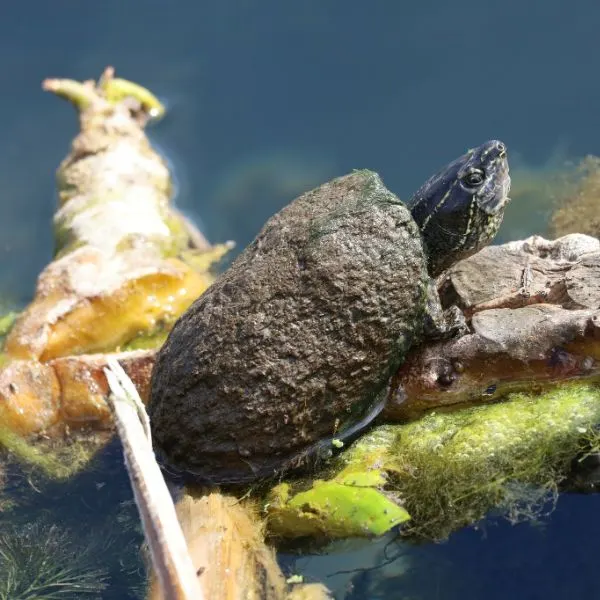
- Experience Level: Intermediate
- Family: Kinosternidae
- Scientific Name: Sternotherus odoratus
- Other Names: Common Musk turtle, Stinkpot
- Adult Size: 4 to 5 inches (10 to 12.5 cm)
- Life Span: 30 to 50 years
- Average Price Range: $30 to $120
- Conservation Status: Least concern
The Eastern Musk turtle has a very common nickname. They are known as “Stinkpots” because they can release a reeking musk when they want to be left alone. Not only that, but these turtles won’t hesitate to bite when you handle them, so beware.
In fact, all turtles from the Family Kinosternidae can release a foul smell from glands located at the back of their shell.
Eastern Musk turtles have an oval shaped shell with a flattened top that is dark grey, brown, or nearly black. They may have darker, but faint starburst patterns, but you’ll better recognize them by the white or yellowish stripes on their heads. These stripes start at the pointed snout and travel behind the head.
These turtles aren’t great swimmers, despite being semi-aquatic, but they can climb. Maybe they should be called semi-arboreal as they can climb trees up to 6 feet tall! Watch out for falling turtles!
These omnivores are more active at night and feed on mollusks, fish, tadpoles, crayfish, small clams, snails, and some plant matter.
Painted Turtles in South Carolina
11. Eastern Painted Turtle
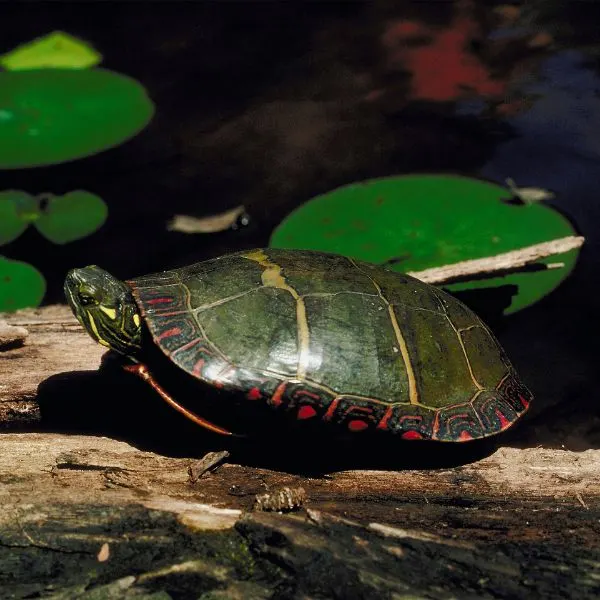
- Experience level: Beginner
- Family: Emydidae
- Scientific Name: Chrysemys picta
- Common Name: Painted Turtle
- Average Adult Size: 4 – 10 inches
- Life Span: 30 – 50 years
- Average Price Range: Between $30 to $150
- Conservation Status: Least Concern
Eastern Painted turtles are a very aquatic species. They only leave the water to bask or lay their eggs. When they experience a severe drought and their watery home dries up they will wander across the land looking for more water, but only because they were forced to.
Painted turtles are the most widespread species of turtles in the United States. They all have similarly shaped carapaces and dark green to black skin with numerous yellow stripes. The way to identify the Eastern Painted turtle is to look at the shell.
The carapace has scutes that line up to form straight lines both horizontal, and longitudinal. The outer edge of the shell can be red but is usually a yellowish color. The plastron is tan to faded yellow and has no patterns on it.
Shallow lakes, streams, ponds, and other slow waters with vegetation, soft bottoms, and plenty of basking spots are where you’ll often find Eastern Painted turtles.
These turtles are omnivorous. They will eat mollusks, worms, crayfish, amphibians, and plants. Most aquatic turtles have to swallow food in the water, but a few of these turtles have been observed feeding on land.
Pond Sliders in South Carolina
12. Yellow Belly Slider

- Experience level: Beginner
- Family: Emydidae
- Scientific Name: Trachemys scripta scripta
- Other Names: Pond slider, Yellow slider
- Average Adult Size: 5 – 13 inches
- Life Span: 50 to 100 years
- Average Price Range: approximately $30 to $130
- Conservation Status: Least concern
Yellow Bellied Sliders inhabit most areas of South Carolina, except for extreme northwestern counties. They are mainly found in watery habitats such as ponds, rivers, marshes, and floodplains. They can sometimes be seen on land as they move between suitable habitats, especially when their watery home dries up.
These turtles have green carapaces with orange, green, yellow, and brown patterns and swirls. Their plastron—as you can guess—is yellow. They often have a pair of dark green spots on the front of their bottom shell.
They look similar to other aquatic turtles, but the yellow stripes on their legs, neck, and head are typically wider than on other turtles.
Younger Yellow Belly Sliders consume a more carnivorous diet of insects, fish, mollusks, carrion, and crayfish, while adults begin to transition to a mostly herbivorous diet. They feed on algae and other green plant matter.
Snapping Turtles in South Carolina
13. Common Snapping Turtle

- Experience level: Intermediate to Expert
- Family: Chelydrida
- Scientific Name: Chelydra Serpentina
- Other Names: Snapping Turtle, Snapper, Eastern Snapping Turtle
- Average Adult Size: 8 to 20 inches
- Life Span: 30 – 50 years
- Average Price Range: Approximately $40 to $120
- Conservation Status: Least concern
Common Snapping turtles are one of the largest freshwater turtles found in the Palmetto State. They can be found in most types of water in South Carolina as they are often considered habitat generalists.
Snapping Turtles prefer larger bodies of water with little to no currents such as lakes, reservoirs, and swamps. While in the water they are quite docile. You could be right next to one and not even know it.
On land though, it’s best to keep your distance. They don’t come on land often, but when they do, they’re a bit grumpy. Common Snapping turtles will hiss to say, “get away,” and if that’s not a big enough hint they will bite.
When you see a large turtle with long limbs, thick front claws, a wide, hooked, beaked mouth, and a long, spiked tail, you’ve seen a Snapping turtle. They have a slightly ridged shell that is dark brown but may appear muddy or covered in algae.
They are usually carnivorous but will consume vegetation. Common Snapping turtles lay on the bottom of the water and wait for food to come to them. They eat nearly anything they can get in their mouths including fish, snakes, crayfish, frogs, salamanders, and small turtles.
Softshell Turtles in South Carolina
14. Florida Softshell Turtle
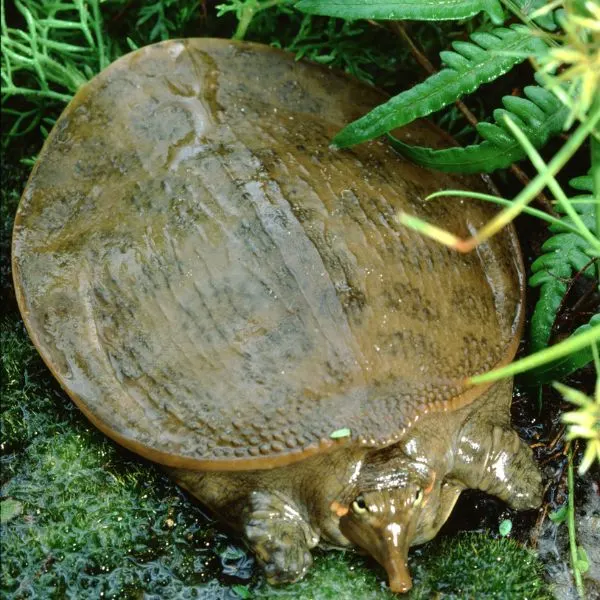
- Experience level: Intermediate
- Family: Trionychidae
- Scientific Name: Apalone ferox
- Other Names: Softshell turtle
- Average Adult Size: 6 – 24 inches
- Life Span: 20 – 50 years
- Average Price Range: approximately $60 – 260
- Conservation Status: Least concern
Florida Softshell turtles can get bigger than Common Snapping turtles, but they don’t weigh nearly as much. They aren’t as beefy as Snapping turtles because they are thin and flattened like a quesadilla.
Softshell turtles don’t have hard shells, instead, they have rubbery or leathery carapaces. These shells don’t offer much protection, indeed, you can often see the outline of their vertebrae and ribs through these shells.
Florida Softshell turtles prefer ponds, streams, and marshes in the southeastern section of South Carolina. They are olive to dark brown with darker spots and blotches on the flexible carapace. Their undersides are much lighter, nearly white with no patterns.
They have large, webbed feet that allow for excellent and fast swimming. Softshell turtles prefer sandy substrates so they can bury themselves and ambush prey such as fish, crustaceans, and other meat sources.
Females can reach astonishing sizes as long as 25 or more inches, while males are stuck growing no bigger than 6 to 10 inches long.
15. Spiny Softshell Turtle
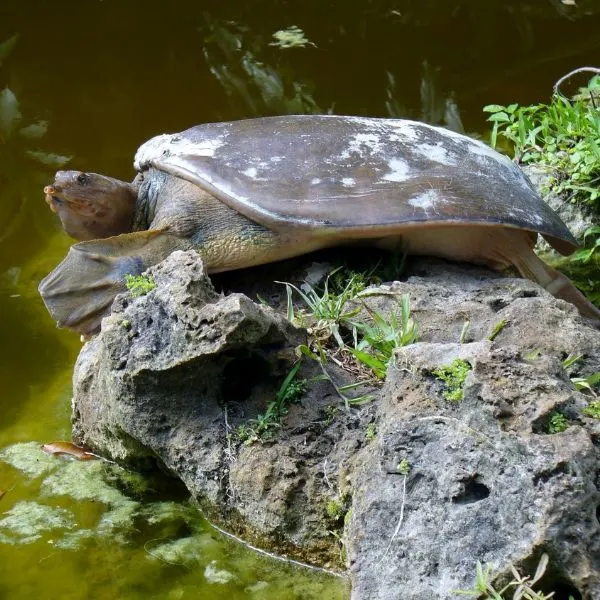
- Experience Level: Intermediate to Expert
- Family: Trionychidae
- Scientific Name: Apalone spinifera
- Other Names: N/A
- Adult Size: 5 to 9 ½ inches for males, 10 to 17 inches for females
- Life Span: Between 20 and 50 years
- Average Price Range: Between $20 and $120
- Conservation Status: Threatened in some areas
Spiny Softshell turtles look very similar to the Florida Softshell. They have the same coloration, a flat, rubbery shell, nodules on the upper carapace, webbed feet, and a long, pointed snout.
The main distinction between these turtles is the Spiny Softshell turtle has pale stripes outlined by black running on the side of the head and onto the neck.
These turtles are found in many types of water, from shallows to relatively deep water. They typically need sandy bottoms though which allows them to camouflage and hunt.
These turtles also eat a mainly carnivorous diet. They will feast on crayfish, tadpoles, amphibians, fish, insects, and mollusks.
Tortoises in South Carolina
16. Gopher Tortoise
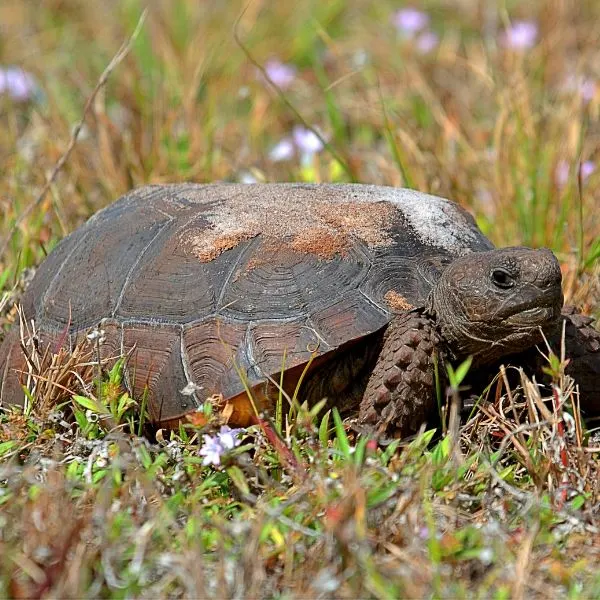
- Experience level: Intermediate
- Family: Testudinidae
- Scientific Name: Gopherus Polyphemus
- Other Names: Gopher turtle, Florida Gopher tortoise
- Average Adult Size: 9 – 15 inches
- Life Span: 40 – 60 years
- Average Price Range: Illegal to sell, but may be adopted with special permits
- Conservation Status: Threatened
The Gopher Tortoise is the only tortoise found in South Carolina. You may ask what’s the difference between turtles and tortoises, well there really isn’t that much. The main difference is that tortoises do not, and cannot swim.
Tortoises are generally herbivores, and usually have much higher domed shells while turtles are more streamlined and suited for an aquatic lifestyle.
The Gopher Tortoise has thick limbs, and the front legs have large, sturdy scales that aid in burrowing. They will dig long, often deep burrows to maintain moisture, escape the summer heat, and hibernate through the winter.
They are nearly endangered and protected. It is unlawful to mess with, harm, or take them or their burrows. The tunnels they dig are used by hundreds of other species, so not only are these turtles incredibly beneficial to the habitat, but other organisms rely on them for survival.
Gopher Tortoises are tan to dark brown and usually dusty looking because they spend so much time in burrows. They are only found in the extreme southern counties of South Carolina in dry, sandy areas.
Since they are herbivores, Gopher tortoises feed on cacti, fruits, seeds, berries, succulents, grasses, and other plants.
Sea Turtles in South Carolina
Five species of sea turtles can be seen off the coast of South Carolina. Sadly, all of these species are endangered. These turtles can sometimes be seen on many of South Carolina’s beaches, while some actually nest on the sandy coast.
Even though they cannot be kept as pets, we’ve provided a few facts about each species in case you spot one in the wild.
17. Green Sea Turtle

- Experience level: N/A, Illegal to own any sea turtle
- Family: Cheloniidae
- Scientific Name: Chelonia mydas
- Other Names: Green Sea Turtle
- Average Adult Size: 3 – 4 feet
- Life Span: 50 – 70 years
- Average Price Range: N/A
- Conservation Status: Endangered
Green Sea turtles can be seen in bays, along reefs, and in the open ocean during the summer months. They have smooth, somewhat heart shaped shells that are greenish, brown, and grey.
They have dark scales that are outlined in white, cream, or yellow. They don’t really have much green on them but that name comes from the flesh under the skin.
You may see Green Sea turtles bobbing along the surface while they get a deep breath of air. They hang around in shallow reefs feeding on algae and sea grasses.
All Sea turtles are endangered because of illegal hunting, egg predation, incidents with boats, and being caught in long, trawling nets.
18. Hawksbill Sea Turtle
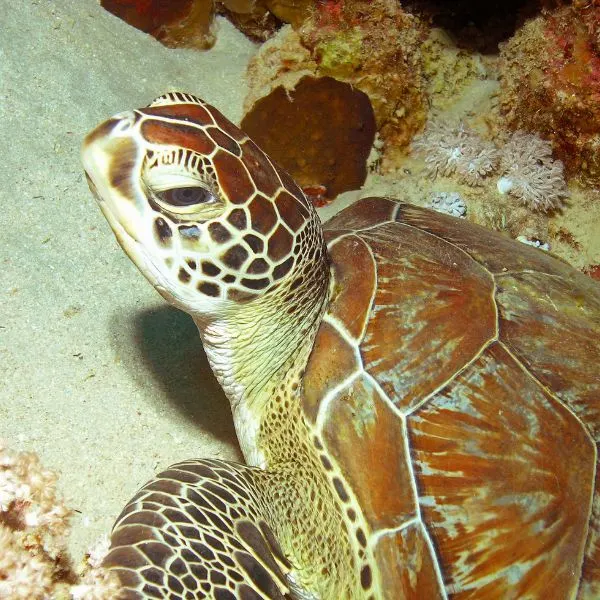
- Experience level: N/A, Illegal to own any sea turtle
- Family: Cheloniidae
- Scientific Name: Eretmochelys imbricata
- Other Names: Hawksbill
- Average Adult Size: 30 – 36 inches
- Life Span: 50 – 60 years
- Average Price Range: N/A
- Conservation Status: Critically endangered
Hawksbill Sea turtles are mainly seen in tropical waters and estuaries. Unfortunately, they have gorgeous, marbled shells with a myriad of ambers, greens, whites, and blacks. This shell is sought after by poachers.
They take these shells and make hair accessories and kitschy items that are sold in many overseas markets. If you see items marketed as genuine “tortoiseshell” it’s probably from a Hawksbill Sea turtle.
These turtles have sharp beaks designed to easily bite off pieces of sea sponges, which makes up the majority of their diet. They also eat fish, sea urchins, algae, and sea grasses.
19. Kemp’s Ridley Sea Turtle

- Experience level: N/A, Illegal to own any sea turtle
- Family: Cheloniidae
- Scientific Name: Lepidochelys kempii
- Other Names: Atlantic Ridley, Tortuga Lora (Mexico)
- Average Adult Size: 24 – 27 inches
- Life Span: 30 years
- Average Price Range: N/A
- Conservation Status: Critically endangered
Kemp’s Ridley Sea turtles are the smallest species of sea turtles. They have green to greyish shells with cream or yellowish skin and undersides. The carapace usually has a serrated ridge along the middle.
These turtles are critically endangered and only inhabit waters in the Gulf of Mexico and along the Atlantic Ocean.
Ridley Sea turtles will congregate together and lay their eggs in massive groups at the same time. These are the only turtles to practice this massive egg laying process.
Kemp’s Ridley Sea turtles feed mostly on crabs, shrimp, and other crustaceans.
20. Leatherback Turtle
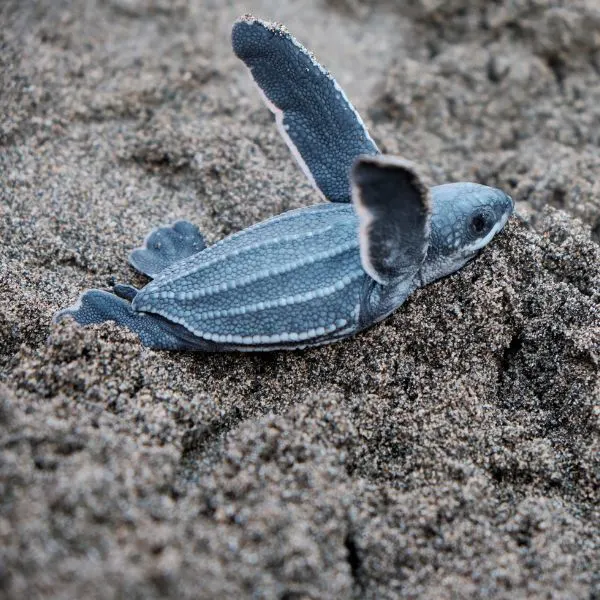
- Experience level: N/A, Illegal to own any sea turtle
- Family: Dermochelyidae
- Scientific Name: Dermochelys coriacea
- Other Names: Atlantic Leatherback, Leatherback
- Average Adult Size: 4 – 8 ft
- Life Span: 30 – 50 years
- Average Price Range: N/A
- Conservation Status: Endangered
Leatherback Sea turtles are the largest turtles in the world. They also have a leathery carapace similar to softshell turtles that is dark grey to black. There are several ridges that run the length of the shell.
Leatherbacks inhabit open waters and rarely ever come to shore once they leave the nest. They can dive up to 4,000 feet deep and will travel over 10,000 miles in yearly migrations.
These huge turtles feed almost exclusively on jellyfish. When they can’t get enough of the watery creatures, they will also feed on fish, sea squirts, and other similar aquatic organisms.
21. Loggerhead Sea Turtle

- Experience Level: N/A, Illegal to own any sea turtle
- Family: Cheloniidae
- Scientific Name: Caretta Caretta
- Other Names: Loggerhead
- Adult Size: 2.5 – 3.5 feet
- Life Span: 70 – 80 years
- Average Price Range: N/A
- Conservation Status: Endangered
South Carolina’s official State Reptile, the Loggerhead Sea turtle is the largest hard shelled turtle in the world. Thousands of these turtles nest along the shores of Florida, and some even make it to South Carolina’s beaches each year.
These turtles have large, somewhat heart shaped shells that are reddish brown. They have long front flippers that are reddish brown on the top, and cream colored on the bottom.
Loggerhead Sea turtles are named for their oversized heads. These heads house massive jaw muscles and a broad, dull mouth. They use these attributes to crack the hard shells of horseshoe crabs, lobsters, conchs, and whelks.
These turtles were designated the State Reptile in 1988 by a 5th-grade class.
FAQs
Can turtles regenerate their shells?
Turtles can grow back small parts of their shells but they can’t regenerate their entire shells. Some turtles flake pieces of their shells off as they grow, but if their shell is drastically damaged, the turtle is unlikely to survive.
If you see a turtle with a broken shell, you may be able to take it to a vet so they can try to heal it, but only if you can do so safely.
Does South Carolina have Alligator Snapping turtles?
Alligator Snapping turtles do not naturally occur in South Carolina. If you see a large turtle, chances are it’s a Common Snapping turtle. If Alligator Snapping turtles are observed in South Carolina, it’s likely an escapee or one that was released by a previous owner.
Can I keep a wild turtle I found in my yard?
It’s best to leave a wild turtle alone, even if it’s in your yard. They are only wandering through as they look for another habitat, food to eat, or a nesting site. Taking wild turtles can be illegal, and can stress the turtle to an early death.
If you see a turtle in your yard, count yourself lucky, and let it move along at its own pace unless it’s in danger or is injured.
Wrapping Up
Hey, you’re still here even after going through 21 species of turtles and tortoises. We appreciate it and hope you enjoyed the list. Now you can identify the species around the state and will be able to check them off your list as you see them in their natural habitat.
If you did learn something or are planning on getting a pet turtle, why not leave us a comment before you go? We love to hear from our readers, and who knows, maybe you’ll connect with fellow turtle enthusiasts.
Other nearby states
